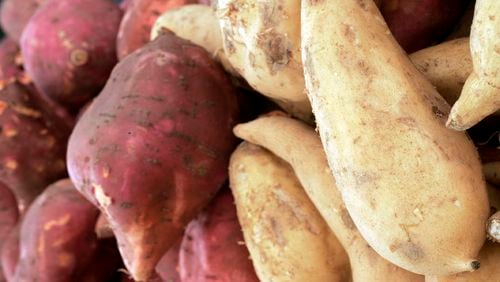Do your eyes have all the nutrients they need to help prevent cataracts, macular degeneration, glaucoma and other sight woes? Here are top foods for eye health, according to the Academy of Nutrition and Dietetics.
--Kale: This leafy green is a rich source of lutein and zeaxanthin, which are related to vitamin A and beta carotene, and are believed to protect eye tissues from sunlight damage and reduce the risk of cataracts and macular degeneration. Other good sources of these nutrients include dark green leafy vegetables such as collard greens, turnip greens and spinach, broccoli, peas, kiwi, red grapes, yellow squash, oranges, corn, mangoes and honeydew melon. Your body needs fat to absorb lutein and zeaxanthin, so be sure to eat them with a bit of healthy fat such as a drizzle of olive oil.
--Sweet Potatoes: These orange tubers are a good source of beta-carotene, which may slow progress of macular degeneration. Your body converts beta-carotene to vitamin A, a nutrient that helps prevent dry eyes and night blindness. Beta-carotene and vitamin A also help reduce the risk eye infections. Other sources of beta-carotene are deep orange foods such as carrots and butternut squash, plus dark green foods including spinach and collard greens. Other sources of vitamin A are liver, milk and eggs. It's always best to get your antioxidants from whole foods rather than popping a pill to get these nutrients. It may be a food's combination of nutrients that have a synergistic healing effect. And, similar to lutein and zeaxanthin, beta-carotene and vitamin A are absorbed best when eaten with a little healthy fat such as olive oil.
--Strawberries: Fresh, juicy strawberries are a good thing for your eyes, and contain plenty of vitamin C, which is an antioxidant that can help lower your risk of cataracts. Also, be sure to load up your plate with other vitamin C-rich foods including bell peppers, broccoli, citrus (such as orange and grapefruit) and cantaloupe.
--Salmon: Dry eyes? Eating enough omega-3 fatty acids can help alleviate the problem. Get some healthy fats every day in the form of salmon or other types of fish (two to three times per week), walnuts (which also contain eye-healthy vitamin E), flax and chia seeds. Salmon also is a good source of vitamin D, which helps protect against macular degeneration. You can also get vitamin D by eating sardines, mackerel, milk and orange juice fortified with vitamin D.
--Green Tea: A cup of green tea is more than relaxing and delicious -- its antioxidants may help lower risk of developing cataracts and macular degeneration. Green tea contains healthful substances called catcehins, which are responsible for its anti-inflammatory and antioxidant properties. Other foods that are that are high in catechins include red wine, chocolate, berries and apples. Black tea also boasts catechins, but in lower amounts than green tea.
Q and A
Q: Are corn tortillas considered whole grain?
A: A whole grain is defined as one that has all three original parts - bran, germ and endosperm - in the same relative proportions as the original grain. For a corn tortilla to be considered a whole grain product, it must be made with whole grain corn flour, and this will be indicated on the ingredient list with words such as "whole corn" or "whole grain corn flour". If the label says "degermed corn", it means the germ has been removed and the product is not whole grain. In other words, you are losing some nutrients and fiber found in whole grain versions of the product. In traditional cultures of Central and South America, corn masa tortillas are made by first soaking the corn in lime water (referring to the mineral lime) in a process called nixtamalization. While this process boosts the nutritional value of the tortilla, mainly by making B vitamins more bioavailable, a small amount of bran is lost during soaking. Because of this loss, some U.S. regulatory agencies, including the FDA, don't consider corn masa a whole grain. However, it still is a good choice. - Tufts University Health & Nutrition Letter.
RECIPE
Sometimes you need dessert. When those moments come, try including fruit to make your dessert healthier. Here's a recipe for a Flourless Rhubarb-Almond Upside Down Cake that is gluten free, using almond flour and a touch of spring with fresh rhubarb. It's from Midwest Living magazine.
Flourless Rhubarb-Almond Upside Down Cake
1/4 cup butter
1/4 cup almonds, toasted and finely chopped
2 cups (1/2-inch-thick) sliced rhubarb (fresh or frozen)
1 cup sugar, divided
1 1/2 cups almond flour
1 teaspoon baking powder
1/4 teaspoon salt
4 eggs, separated
1/2 teaspoon almond extract
1/2 teaspoon vanilla
Preheat oven to 350 degrees. Place butter in a round 9-inch cake pan. Place pan in oven for 5 minutes or until butter melts. Remove pan from oven. Sprinkle almonds over butter in pan. Arrange rhubarb over almonds in a single layer. Sprinkle with 1/2 cup of the sugar. In a small bowl, stir together almond flour, baking powder and salt; set aside. In a large bowl with an electric mixer, beat egg yolks, 1/4 cup of the sugar, the almond extract and vanilla until light and fluffy. Stir in flour mixture. Clean beaters and in a medium bowl, beat egg whites until soft peaks form. Fold egg white mixture, one-fourth at a time, into egg yolk mixture. Spoon batter over fruit mixture in pan, spreading evenly. Bake for 30 minutes. Cool in pan for 10 minutes. Loosen cake from sides and invert onto a serving plate, replacing any rhubarb that stays in pan. Serve warm or cool. Makes 8 servings.
Per serving: 339 calories, 9 g protein, 32 g carbohydrate, 21 g fat, 108 mg cholesterol, 224 mg sodium.






